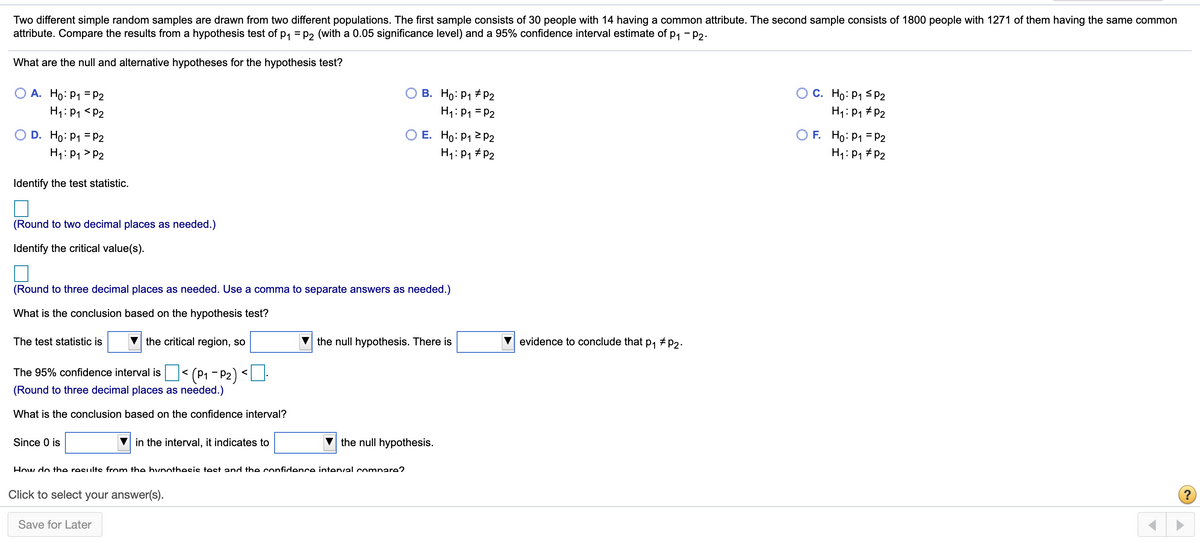Two different simple random samples are drawn from two different populations. The first sample consists of 30 people with 14 having a common attribute. The second sample consists of 1800 people with 1271 of them having the same common attribute. Compare the results from a hypothesis test of p, =P2 (with a 0.05 significance level) and a 95% confidence interval estimate of p, -P2. What are the null and alternative hypotheses for the hypothesis test? O A. Ho: P1 =P2 H: P P2 OF. Ho: P1 =P2 H: P, *P2 O E. Ho: P, 2 P2 H: P1 + P2 Identify the test statistic. (Round to two decimal places as needed.) Identify the critical value(s). (Round to three decimal places as needed. Use a comma to separate answers as needed.) What is the conclusion based on the hypothesis test? The test statistic is V the critical region, so V the null hypothesis. There is V evidence to conclude that pP, P2- The 95% confidence interval isO< (P1 - P2)
Two different simple random samples are drawn from two different populations. The first sample consists of 30 people with 14 having a common attribute. The second sample consists of 1800 people with 1271 of them having the same common attribute. Compare the results from a hypothesis test of p, =P2 (with a 0.05 significance level) and a 95% confidence interval estimate of p, -P2. What are the null and alternative hypotheses for the hypothesis test? O A. Ho: P1 =P2 H: P P2 OF. Ho: P1 =P2 H: P, *P2 O E. Ho: P, 2 P2 H: P1 + P2 Identify the test statistic. (Round to two decimal places as needed.) Identify the critical value(s). (Round to three decimal places as needed. Use a comma to separate answers as needed.) What is the conclusion based on the hypothesis test? The test statistic is V the critical region, so V the null hypothesis. There is V evidence to conclude that pP, P2- The 95% confidence interval isO< (P1 - P2)
College Algebra (MindTap Course List)
12th Edition
ISBN:9781305652231
Author:R. David Gustafson, Jeff Hughes
Publisher:R. David Gustafson, Jeff Hughes
Chapter8: Sequences, Series, And Probability
Section8.7: Probability
Problem 58E: What is meant by the sample space of an experiment?
Related questions
Question
please help solve attached
What is the conclusion based on the hypothesis test?
The test statistic is not in or in the critical region, so fail to reject
reject or fail to reject the null hypothesis. There is sufficient or insufficien evidence to conclude that p1≠p2.
What is the conclusion based on the confidence interval?
Since 0 is not included or included in the interval, it indicates to reject or fail to reject the null hypothesis.
How do the results from the hypothesis test and the confidence interval compare?
The results are the same or different since the hypothesis test suggests thatp1 is less than or equals≤, greater than or equals≥, greater than>, equals= less than< , or not equals≠ p2, and the confidence interval suggests that p1 less than or equals≤, greater than or equals≥, greater than>, equals= less than< , or not equals≠.

Transcribed Image Text:Two different simple random samples are drawn from two different populations. The first sample consists of 30 people with 14 having a common attribute. The second sample consists of 1800 people with 1271 of them having the same common
attribute. Compare the results from a hypothesis test of p, = p2 (with a 0.05 significance level) and a 95% confidence interval estimate of p1 - P2.
What are the null and alternative hypotheses for the hypothesis test?
A. Ho: P1 = P2
B. Ho: P1 + P2
H1: P1 = P2
O C. Ho: P1 <P2
H1: P1 # P2
H1: P1 <P2
O D. Ho: P1 = P2
E. Ho: P1 2 P2
F. Ho: P1 = P2
H1: P1 > P2
H1: P1 # P2
H1: P1 # P2
Identify the test statistic.
(Round to two decimal places as needed.)
Identify the critical value(s).
(Round to three decimal places as needed. Use a comma to separate answers as needed.)
What is the conclusion based on the hypothesis test?
The test statistic is
the critical region, so
the null hypothesis. There is
evidence to conclude that p, + P2.
(P1 -P2) <
The 95% confidence interval is
(Round to three decimal places as needed.)
What is the conclusion based on the confidence interval?
Since 0 is
in the interval, it indicates to
the null hypothesis.
How do the results from the hvnothesis test and the confidence interval compare2
Click to select your answer(s).
?
Save for Later
Expert Solution
This question has been solved!
Explore an expertly crafted, step-by-step solution for a thorough understanding of key concepts.
This is a popular solution!
Trending now
This is a popular solution!
Step by step
Solved in 3 steps with 2 images

Knowledge Booster
Learn more about
Need a deep-dive on the concept behind this application? Look no further. Learn more about this topic, statistics and related others by exploring similar questions and additional content below.Recommended textbooks for you

College Algebra (MindTap Course List)
Algebra
ISBN:
9781305652231
Author:
R. David Gustafson, Jeff Hughes
Publisher:
Cengage Learning

College Algebra (MindTap Course List)
Algebra
ISBN:
9781305652231
Author:
R. David Gustafson, Jeff Hughes
Publisher:
Cengage Learning